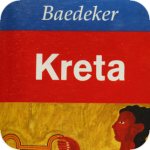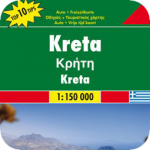
 Zorba 50 years later
Zorba 50 years later Have you already had the opportunity to read the book by Tomasz Zaród "Zorba 50 years later published by @greckie klimaty? We are fresh after reading and would like to share our insights about it with you. This is a very unique project that we are pleased to be the media patron of.
 Guide to Baedeker - Crete
Guide to Baedeker - Crete The nearly 300-page Baedeker guide issued by the Pascal publishing house in 2007 (issue 1) is almost an encyclopedic item. Baedeker has 150 years of experience in creating tourist literature and tries to publish his publications tailoring them to the needs of tourists. The guide is very comfortable in many ways and its formula well thought out and refined.
 Guide to Crete from the Navigator series
Guide to Crete from the Navigator series The Navigator Guide from the Navigator series is relatively cheap and will not deplete your portfolio too much. For about PLN 20 you will get a well-published small book that has been printed on thick paper of good quality. In our opinion, this pocket edition from the Navigator series will be a perfect complement to encyclopedic guides such as the "Crete" Baedeker publishing house. Recommended.
 Pocket guide Dumont - Crete
Pocket guide Dumont - Crete The "Kreta" guide from Dumont publishing house (in Poland printed by PWN) is another very handy pocket publication that is sold at a reasonable price of less than PLN 20. As with other such small guides, you will not find many descriptions of places here, and the amount of information provided is clearly limited by a small format of 19 x 10 cm and a small number of pages. Despite these restrictions Klaus Bötig managed to put quite a lot of interesting information in it.
 Pocket guide RM Kreta from the inside
Pocket guide RM Kreta from the inside The Discovery Channel guide published by the RM Publishers in 2007 is a 120-page translation of the English collective study. The main author of the texts is Brigitte Seckendorff-Kourgierakis, who, while working on this guide, crossed Crete along the breadth. For this reason, this book is a special item on our market because it is based on the experience of the author and her friends.
 Crete map of the Freytag & Berndt publishing house
Crete map of the Freytag & Berndt publishing house The Freytag & Berndt map is a great affection, because its previous edition has faithfully accompanied us during several previous trips. Despite such a long period of exploitation, it is difficult to remember the situation in which this map "lost" us in Crete. Even its gigantic dimensions sometimes proved to be an advantage, because often this map landed during a standstill under the windshield of the car, acting as a roller blind protecting the cabin from the sun :).
 Crete Guide to the Pascal publishing house
Crete Guide to the Pascal publishing house Pascal's Guide to Crete from 2006 (with resumption in 2009) belongs to the series of guides around the world, which are characterized by a small format (24 x 11 cm), a soft spiral binding and a colorful cover with a large, vertical name of the described place. This graphic design makes these guides easily recognized on the shelf in the bookstore. The Crete Guide is a collective study translated from English with 192 pages.
 CRETE - ExpressMap, not exactly comfort! maps
CRETE - ExpressMap, not exactly comfort! maps Crete - ExpressMap is a double-sided laminated map in the cover. Its dimensions are small: 100 x 48 cm after unfolding, and in the composite form it is only 11 x 24 cm. The plan of Crete was presented in 1: 150,000 scale. In addition, the publisher on both sides also posted the plans of major cities: Heraklion, Rethymnon, Chania, Agios Nikolaos, Ierapetra and Sitia, which are sketched on a scale of 1:10 000. There is also a small plan of islet Gavdos (1: 150,000).
 Car map of Crete - Terrain
Car map of Crete - Terrain The Terrain publishing product is a rather compact 1: 200,000 car map sold in a rigid plastic case that will surely perform well in protective functions. It is worth mentioning that the material from which it is made is some artificial material (or paper composite) that is waterproof and very strong. You must use a lot of force to break the map or use some sharp tool. It certainly bodes well when it comes to its lifespan.
 Dionisios Sturis - Greece. Bitter oranges
Dionisios Sturis - Greece. Bitter oranges Anyone who is close to the topic of Greece certainly knows the name of Dionisios Sturis, who for a long time is trying to bring the problems of Ellada residents to the Poles. Many people associate him with the TOK FM radio, where he is a "duty" journalist dealing with the strike of Greece.
For people who are going to Crete for the first time, we have prepared a set of basic information useful during their stay on the island. The following topics are relevant from our point of view and we have described them based on our own experience. Of course, this article does not cover all topics, and it is likely that this toolkit will grow over time.
The website contains a description of the factors affecting the number of stars awarded by EOT to individual hotels. The current hotel rating system in Greece is based on four basic categories, which in the descending order (from the best to the weakest category) represent the letters L, A, B and C. The Greek way of assessment is characterized by a wide variation in the quality of rooms in hotels in the same category EOT. A large discrepancy results from the award of a large number of component points for the assessment of public space, i.e. reception, waiting room or swimming pool.
Komentarze
Wypełnij poniższy formularz aby dodać komentarz